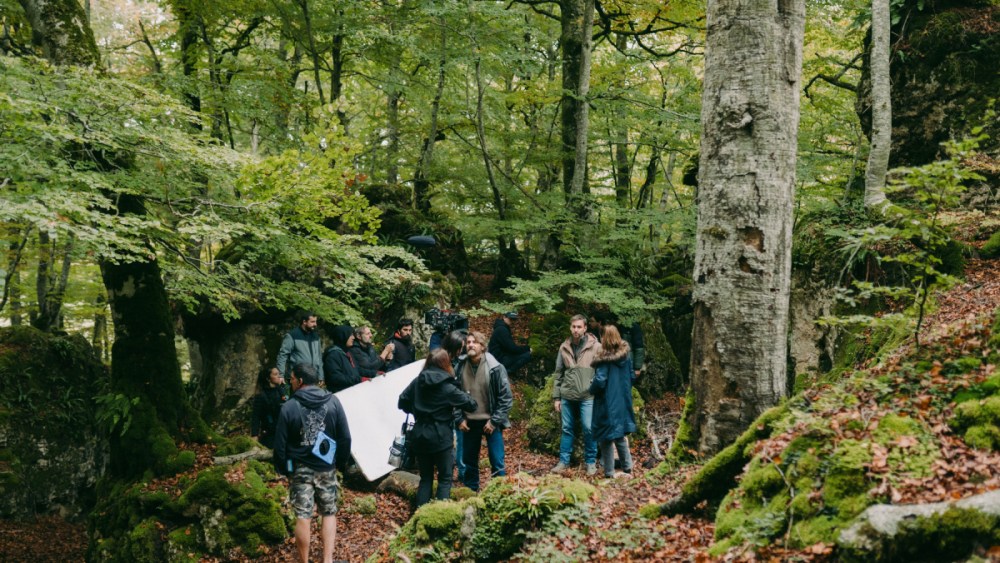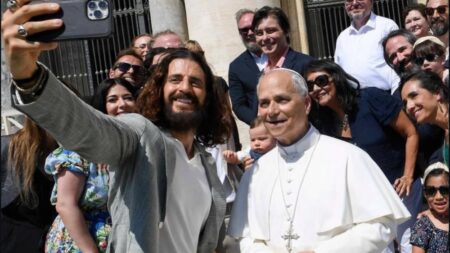Of all the highlights at last week’s Spanish TV forum Conecta Fiction, one of the biggest was a sneak peak reveal of a teaser-trailer to “La Caza. Irati,” Season 4 of a franchise which is shaping up as one of Spain’s biggest crime dramas.
Seasons 1-3’s anchor broadcaster was Spanish public-broadcaster RTVE. Set to bow later in 2025, “Irati” is set up at Movistar Plus+, boasts a significantly larger budget, but repeats the potent mix of a missing persons/murder mystery, strong characters inviting audience engagement and sharp thematic observance, here in Irati” how fiction shapes reality.
Set in the stunning forests of Navarre, Northern Spain, “La Caza. Irati” marks the latest series from José Manuel Lorenzo’s DLO Producciones, part of Banijay Entertainment, Europe’s biggest scripted studio, created by renowned novelist-screenwriter Agustín Martínez.
Lorenzo and Martínez broke through with the first flowering of Spanish scripted series from the mid-1990s, Lorenzo as a top TV exec, Martínez penning iconic series such as teen soap “Al Salir de Clase” which blew U.S. series out of the ratings waters.
Both, it could be argued, as a producer and writer have only hit full stride and an international reach in TV with the advent of streamers, notably Netflix and Movistar Plus+, and the reaction of incumbent broadcasters in Spain, essaying series which aimed to combine broad audiences with a TV edge.
Over little more than the last 12 months, two DLO shows have topped Netflix non-English language charts for a combined month: high-school sexual assault drama “Raising Voices” ranked No. 1 over May 27-June 9 last year; green-fingered serial killer thriller “The Gardener” followed suit over April 7-20. Meanwhile, DLO’s “El Inmortal” played Canneseries main competition in 2022.
‘La Caza,’ the TV Crime Franchise to Date
Based on Martínez’s own novel, an international best-seller, “La Caza. Monteperdido” broke out to way above channel ratings on RTVE prime time, its first season bowing out with a 15% audience share, compared to RTVE’s total 9% channel average for 2019. Including Seasons 2 (“La Caza. Tramontana,” 2021) and 3 (“La Caza. Guadiana,” 2023), “La Caza” averaged averaging an 11.6% audience share and 1.89 million viewers per episode, including online catch-up viewers.
Released on Netflix in Spain in a second widow, “La Caza” shot to the top of the streamers’ Spanish charts.
Launched last year on TF1, French adaptation “Rivière Perdue” averaged 5.6 million viewers in primetime, becoming TF1’s most successful miniseries since 2021, which is saying something given TF1’s dominance of free-to-air ratings in France.
Shot in Benasque, now called Monteperdido, the biggest country town in Spain’s Pyrenees in the lap of the highest Posets-Aneto massif in the range, “Monteperdido” turns on the sudden disappearance of two young school-girls in a snowy path from school to home. Five years later, one, Ana, appears alive.
Lucia, the other, still can’t be found. Sara Campos (Megan Muntaner, “3o Coins”), a buttoned Civil Guard sergeant, drives herself to physical and mental exhaustion trying to find Lucía as she battles her own inner demons, a form of schizophrenia, aided by Victor (Alain Hernández), a local corporal.
“Tramuntana” moves Sara to her native Mallorca and its highest mountain range, riven by gorges, sinkholes and caves, as she takes on the horrific murder of a local priest, reencounters her father, and finally tackles her childhood trauma.
Set at Guadiana de la Frontera, a small hill of whitewashed houses nestling on the banks of Andalusia’s Guadiana River separating Spain and Portugal, “Guadiana” sees Sara, Victor and Civil Guard lieutenant Ernesto Selva (Félix Gómez, “Alpha Males”) investigate the disappearance of a woman.
“La Caza 1-3” is Sara’s story, from her reconciliation with herself and her mental illness as she falls in love with Victor– “It’s as if for a long time I’ve had a thorn in the sole of my foot and you finally get used to it, and even forget it. But now I don’t have it,” she says to Victor, in his arms, in Season 2.
Seasons 1-3 turn on the damage adults do to children and the need for belonging. “I’ve never formed part of anything, not even my friends and the village,” the psychopath serial killer of Season 3 admits.
Themes of family, biological or found, and their need, course all three seasons. “We look like a family,” one of the girls abused in Season 2 says to her friends of a drawing of them, as they steal themselves for social abuse after helping to expose a paedophilic network on the island. Engendering much of the series’ emotion, Sara’s journey is from solitude to form a family living in Victor’s birthplace, Monteperdido.
Martínez and co-scribes – notably Luis Moya (“Paco’s Men,” “Money Heist”) and Miguel Sáez Carral (“Raising Voices,” “The Gardener”) – create edge-of-the-seat tension, notably in Season 1, which begs multiple questions: Are both missing girls alive? Who abducted them? And will the Civil Guard investigators make it out alive?
“La Caza” has its Red Wedding moments. Deaths – priest Bernat’s murder opening Season 2, for instance – can be graphic.
La Caza. Irati
Courtesy of Banijay
What ‘La Caza.Irati’ Promises
What Lorenzo and Martínez will make of “La Caza. Irati” was anybody’s guess until last week’s Conecta Fiction. There may now be some inkling. Season 4 is shot in the Irati Forest, said to be the second largest and best preserved mixed birch-fir woodland in Europe, as well as the nearby Sierra de Urbasa mountain plateau, its karst rock caves and potholes echoing those in “Tramuntana,” as well as Navarre capital Pamplona.
From a promo shown at Conecta Fiction, a corpse of a woman is found hanging from a tree, upside down, in a copse outside a remote village. Sara, still part of the Civil Guard Central Operative Unit (UCO), its task force, but now a psychologist, and Selva, are drafted in as Selva gets a new boss, played by Silvia Alonso (“Instinto”), which grates with his freewheeling spirit.
One suspect is an aged local man, a widower. As further murders follow, however, the villagers speak of a figure, known as “the Creature,” lurking in a forest steeped in local mythology: One cutaway shot takes in a rune stone, hidden in the forest, bearing a mysterious inscription. Meanwhile, a group of adolescents run wild in the forest.
As in much of “La Caza,” the setting is spectacular, the Irati Forest caught in its full Fall splendor, as its pathways are clogged by golden-brown leaves, adding a fictional fairy tale air to woodland scenes. The trailer is splendidly shot, speaking of probably high production values.
Variety chatted to Lorenzo and Martínez about what to expect in Season 4:
Why change operator from RTVE to Movistar Plus+?
Lorenzo: We’d made Seasons 1-3 with RTVE but RTVE budgets are very tight. I proposed co-producing “La Caza. Irati,” with Movistar Plus+ which had been interested in the series for a long time, so we could make a bigger series, with RTVE contributing the same. We continued talking but RTVE asked me to wait a few more months. But by that time the series was set up, the contracts, location deals sealed. I had to shoot at a certain date and Movistar Plus+ was willing to back Season 4.
You’re working on a bigger budget?
Lorenzo: Significantly so. The season is on a far larger canvas with many more actors, shot entirely in Navarre and it’s also the most open expansive season yet. Its production values are above the norm in Spain. With Movistar Plus+, I’ve been able to make the best season of “La Caza” to date.
Why the best?
Lorenzo: The story is jaw-dropping. Agustín [Martínez] knows “La Caza” through-and-through. It’s a world he’s created from the get-go, from his first novel, which I acquired the rights to. I liked it a lot, and Agustín has a very clear idea about the characters and so on. We shot in magical places, the Irati Forest, and woods of the Sierra de Urbasa, plus Pamplona, which is spectacular. We shot everything there. Unlike the first three seasons, I didn’t have to use Madrid to stand in for other locations.
Agustín describes “La Caza” Seasons 1-3 as Sara’s journey. What is that journey in Season 4?
Lorenzo: Sara still has an important role but she changes from a hands-on Civil Guard sergeant to a psychologist who helps the Civil Guard and victims of violence. I like that her character evolves, we don’t want to ever repeat ourselves. What also makes me happy is the incorporation of Silvia Alonso as Megan, Selva’s new boss. So Megan and Selva work with weapons in hand and Sara works with her mind, drawing on her experience with trauma. This is the most psychological series of all four.
Setting Season 4 in the Irati Forest allows you to draw on a historical legacy of centuries where negative events were blamed not on the consequence of human actions but the supernatural, be it witches or mythological creatures. Was that the setting’s attraction?
Martínez: There were two concepts which drew us to Irati, connected to what you’re saying. I was attracted to a place isolated from the rest of the world, which was its own society. Of all the villages in the series, this is the smallest. Also, I wanted a season closer to the world of horror, questioning throughout it the lines between reality and fiction, and how fiction can shape reality.
That fiction includes local mythology?
Martínez: Yes, it’s folklore, like the water spirts and the goddess Mari, part of Basque-Navarre myth. In “Irati,” some characters have created a fiction around their lives which has grave consequences. As you’ve said, for human beings it’s easier blame a fantasy creature, a demon. The whole series questions whether there’s a real creature or it’s invented by the villagers.
That creates doubled edge suspense: What or who is the murderer. Producer Manuel Martí (“Tu parte del trato”) once said that suspense drive audiences to finish episodes, but characters to return to series.
Martínez: For me thrillers, especially when tinged with horror, are a support structure, to construct stories which are gripping, and which gives you the chance to talk about personal and emotional conflicts which really drive the story, and not just those of the three protagonists. In “Irati,” we discover a world with a recent taciturn widower, his whole life destroyed, and there’s a group of youths, who run wild, practically order around their parents, and are pushing boundaries on drugs, alcohol, sex and even violence. This world of characters is at the heart of the story. What really grabs you are the dramas you tell about each character.
With second and third streamer windows, series are seen ever more abroad. How does that effect your concept of audience and use of local detail?
Martínez: I think it was Faulkner who said that the more local, the more global. When I watch a German series, I want to be told something specific about Germany. If you make something which is generic, with the ambition of it being understood in the whole world, it loses personality and identity. Beside series, I also write novels which have been translated into a large number of languages. Thrillers and mysteries travel very well but what’s also highly valued is the cultural identity of the novels and the kind of characters we create in Spanish thrillers are completely different to those in Nordic literature, in “Millennium,” for example. Their conflicts are universal and comprehensible but very specific, very much of the place where the characters live. That’s something I worked on a lot in “La Caza.” The characters in “Irati” won’t be the same as those in “Guadiana” and “Tramuntana.” They’re different because they live in a specific place with a specific culture.

Agustín Martínez and José Manuel Lorenzo
Courtesy of Banijay
Read the full article here








